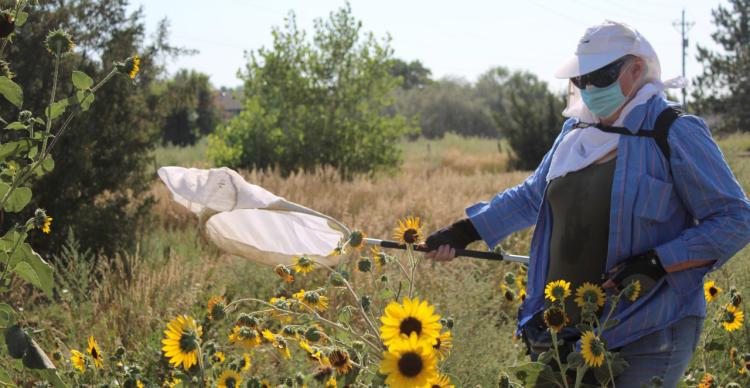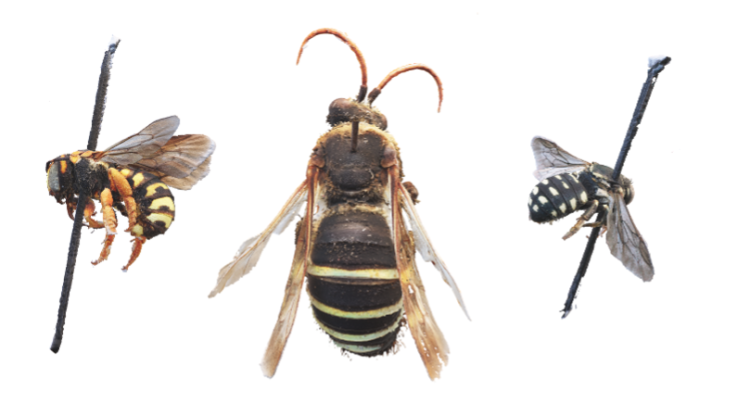The CU Museum is closed we will be opening early in the spring semester.
During this time, collection visits will be available by appointment and other special access requests will be considered on a case-by-case basis.
Please email cumuseum@colorado.edu for more information.
Research

Curatorial Research
Approximately 15% of the collection’s 1.4 million specimens have been databased. Thus, a priority for the collection is the digitization of specimen records and modernization of how specimens and associated data are curated. The Entomology Collection has been a part of two recent large-scale collaborative projects to digitally curate museum insect specimens. The most recent museum project is in collaboration with the NSF Thematic Network Collection project, Big-Bee. The goal of Big-Bee is to expand bee research through the digitization of not just bee specimens but also bee traits using imaging and macrophotography. To accomplish this goal, the collaborative group of 16 institutions is creating over 1.2 million images of more than 5,000 bee species, shared via the Bee Library. For our part, the UCMC Entomology Section is digitizing >62,000 bee specimens, creating >10,000 high resolution 2D focused stacked images of exemplar bee specimens, and rendering >100 3D photogrammetric models of different bee species. These high-resolution images and models are already being used to help describe never before observed variation in sexual traits (Mullins et al. in press) and will be used for both research and outreach within the museum.

The Entomology Collection has also been a part of the NSF-funded Symbiota Collections of Arthropod Network (SCAN) since 2013. The goal of this project is to support arthropod collection digitization efforts, including databasing, imaging, and data sharing. The SCAN data portal contains thousands of arthropod occurrence records from many collections. For SCAN, the CU Entomology Collection has prioritized digitizing ground-dwelling insects and has developed effective workflows for high-resolution macrophotography of specimens using a focus-stacking system.
Funding from the Institute of Museum and Library Sciences through a grant, Enhancing preservation and accessibility of a unique arthropod collection from the mountains of Colorado, has allowed us to preserve a unique and valuable collection of over 320,000 arthropods (ants, bees and wasps, beetles, grasshoppers, and arachnids) systematically collected across elevations in the Rocky Mountains. The project has sorted, curated, barcoded, and rehoused this unique, valuable collection, thus preventing the deterioration and ultimately the loss of these specimens and their associated data. Data from these specimens are being published through various public sources (SCAN, GBIF) that will allow researchers and the public access. This project also trained a number of undergraduate and graduate students in collections best practices, contributing to future generations of museum professionals.
Grasshoppers and Climate Change
With the support of the National Science Foundation, the Entomology Section curated and databased the Gordon Alexander Orthoptera Collection. This collection is largely composed of 24,000 grasshoppers collected near the Front Range of Colorado. An important subset of these specimens was collected along an altitudinal gradient near Boulder, Colorado by Gordon Alexander and John Hilliard during the summers of 1958 to 1960 (Alexander and Hilliard 1969; see grant for citation source). We have resurveyed the main collecting sites used by Alexander and Hilliard to determine how climate change and land use patterns may have impacted the grasshoppers of the region over the last 50 years.
Biodiversity Research
Members of the Entomology Section have also been involved in a number of different collaborative projects that investigate various aspects of insect biodiversity. Given the section’s expertise in CO insects it has been involved in a several projects exploring insect biodiversity in Colorado, specifically pollinators. Other research has focused in areas outside of Colorado, such as our work on the consequences of introduced weeds on native herbivores and their natural enemies.
Land Use Change
With increasing demand for agricultural commodities expected to alter land-use and land-cover in agricultural landscapes, it is imperative to identify and measure potential impacts on wildlife within these agroecosystems. In particular, there is growing concern about how bees and other pollinators will respond to these altered landscapes and land-use practices. As part of a collaborative USDA National Institute of Food and Agriculture grant, we aimed to 1) complete comprehensive surveys of bee communities in agroecosystems of eastern Colorado, 2) explore patterns of bee abundance and diversity in relation to agricultural land-use and practices, and 3) provide information needed for identifying potential risk factors for bees and for developing strategies for pollinator conservation. To date, this project has vouchered 36,661 bee specimens and thousands of other insects, including 425 new county-level, 97 new regional, and 15 new state records for bees not previously known to occur in Colorado (Jamieson et al 2019). This includes species for which their known distributions have been greatly expanded, like Cemolobus ipomoeae, formerly considered an eastern deciduous forest specialist (Carper et al 2019). Moreover, we found that conservation plantings in agroecosystems are an important resource for native pollinators (e.g., Schwantes 2015) and can help mitigate the negative impacts of intensive row cropping. We have also collaborated on a number of studies in and around Denver, to explore the impacts of urbanization on pollinators, and what mechanisms can help mitigate urban habitat loss (e.g. Birdshire et al. 2020).
Grasshoppers and Climate Change
With the support of the National Science Foundation, the Entomology Section curated and databased the Gordon Alexander Orthoptera Collection. This collection is largely composed of 24,000 grasshoppers collected near the Front Range of Colorado. An important subset of these specimens was collected along an altitudinal gradient near Boulder, Colorado by Gordon Alexander and John Hilliard during the summers of 1958 to 1960 (Alexander and Hilliard 1969; see grant for citation source). We have resurveyed the main collecting sites used by Alexander and Hilliard to determine how climate change and land use patterns may have impacted the grasshoppers of the region over the last 50 years.
Participatory Science: The Bees' Needs
From 2013-2017, we ran a participatory science project called The Bees’ Needs. The goal of The Bees’ Needs was to monitor and better understand native, solitary, wood-nesting bee and wasp diversity in Colorado. Roughly 300–400 bee blocks were distributed to volunteers each year, and citizen scientists reported biweekly data on bee nesting activity from April through October each year. The Bees’ Needs partnered closely with the Entomology Collection to analyze data and voucher bee specimens collected as part of the project and many projects are still resulting from the collected data. For example, a recent graduate student, used these observations to construct a key to the wood-nesting bees and wasps in the region and was able to correctly classify >90% of all nests using just four variables: nest plug composition, date of nest completion, nest diameter, and elevation (Jolma 2023). We hope to use this to help inform monitoring projects around the Front Range.
Climate, Extreme Weather, and Riparian Management
Riparian habitats are important for many bee species providing important nesting and floral resources, but are under threat as climate change increases the frequency and intensity of disturbances like flooding. However, surprisingly little is known about bees’ responses to flooding or how management post-flood impacts pollinators. In September 2013, an unprecedented flood occurred along Colorado’s Front Range, and some areas in the mountains of Boulder County received as much as a year’s worth of rain during this one week. The St. Vrain Greenway, an 8-mile trial that runs east-west through the city of Longmont, was catastrophically flooded. Having recently conducted a survey the previous year (2012). We conducted post-flood surveys in 2014 and 2020 to determine the effects of catastrophic flooding on bee communities. Wild bee abundance and genus richness declined on average by 24% and 19%, respectively immediately following the flood, but increased by 14% and 18%, respectively from 2014 to 2020, suggesting partial recovery of the wild bee community seven years post-flood (Mullins 2021). However, not all restoration activities were beneficial to bees. In a survey of open spaces where woody debris from the flood was either left or removed, wood removal reduced overall bee abundance by 40%, wood-nesting bees by 37% and soil and hive nesting bees by 41% (Carper & Bowers 2017), suggesting that flood debris offered both nesting and ecosystem-wide benefits to the bee community. These highlights the value of restoration in riparian habitats for pollinators but also underscores the need for pollinator research in order to promote resilient habitats in the face of a changing climate.
Effects of novel host plants on plant-caterpillar-enemy interactions
In a rapidly changing environment, the value of understanding the complexity of species interactions cannot be overstated. This includes the formation of associations between parasites and novel hosts. A grant from the National Science Foundation has funded research investigating the interaction between a virus that infects butterflies on both their native food plant and a recently adopted exotic food plant. This newly discovered virus has unknown consequences for populations of butterflies; however, prior research suggests that the chemistry of the food plants may have therapeutic effects. This project investigated whether and how the outcome of viral infection on individuals and populations of Baltimore checkerspot butterflies depends on the choice of a native or exotic host plant. The research also studied how parasitic wasps that attack the caterpillars might alter the entire set of interactions between the butterflies, food plants and the virus. By understanding disease dynamics within human-altered environments, detrimental impacts on species can be mitigated. This project included a museum exhibit on caterpillar defenses, a symposium on insect-virus ecology, and the inclusion of undergraduate and graduate student research.
This project takes advantage of a recently formed interaction between the Baltimore checkerspot butterfly (Euphydryas phaeton, Nymphalidae) and the exotic narrow-leaved plantain (Plantago lanceolata, Plantaginaceae) to develop mathematical models for macro-parasite population dynamics on a novel plant species. Predictions will be tested using laboratory and mesocosm experiments that include infection with butterfly “enemies”, a naturally-occurring entomopathogenic virus and parasitoid wasp, both of which attack caterpillars of the butterfly. The overarching question of this project is: Can we predict persistence of the butterfly populations from the interactions with enemies on native and exotic host plants?

